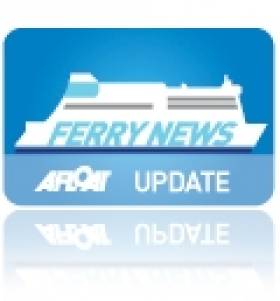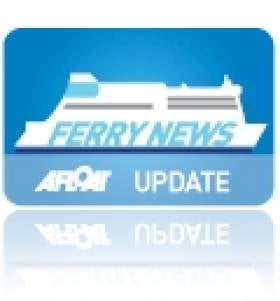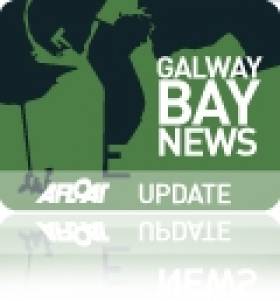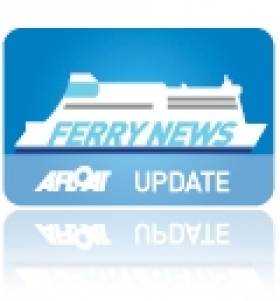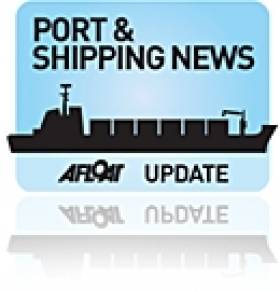Displaying items by tag: Ports and Shipping News
Dublin Based d’Amico Order Pair of Eco-Product Tankers
#TANKER NEWBUILDS – The Dublin based d'Amico Tankers Limited (Ireland), has entered into contracts for the construction of two additional new product/chemical tanker vessels.
Each of the 40,000 dwt handysize newbuilds, believed to cost US$ 30.65 million, are to be built by the Hyundai Mipo Dockyard Co. Ltd in South Korea. Delivery dates are expected early in 2014 and an option for two further vessels, under same terms and conditions, to be exercised by the end of this year.
The design of the newbuildings is double-hulled, flexible and IMO classed vessels, which belong to a new generation of vessels. Under a new concept the 'Shallowmax' vessels will have a lower fuel consumption/high efficiency and cubic/shallow-draft combination.
According to DIS, d'Amico Tankers Limited, have signed 'time-charter' agreements with one of the main oil majors for the newbuild pair for a period of five years. d'Amico Tankers Ltd control a fleet of 40 double-hull medium range (MR) and handysize product tankers. Following the latest newbuilds the fleet will increase to 24 owned vessels and 18 chartered vessels.
Irish Ferries Appoints New Head of Passenger Sales
#FERRY NEWS –Irish Ferries has appointed Dermot Merrigan as Head of Passenger Sales for Ireland, UK and France.
Merrigan joined Irish Ferries 22 years ago and has extensive experience within the company's passenger business. Previously he held the posts of Contact Centre Manager and, before that, Commercial Coordinator with the company's division Irish Ferries Holidays.
A native of Dublin, he is married and succeeds Declan Mescall who retired after 34 years service with the company.
#NEWBUILD BULKER ORDER– Irish based d'Amico Dry with offices in Dublin, has ordered six 40,000 dwt bulk carrier newbuildings, with options for further six vessels, from China's Yangfan Group.
The company which is a fully owned subsidiary of the d'Amico group, has made the $134m deal, which values each handymax at $22.3m. The order for the new ships has been financed through bank lending.
Chief executive of d'Amico Cesare d'Amico said: "The new vessels will strengthen our position in the handysize market, which we feel has a great capacity for future growth, and also demonstrate our commitment to the environment by significantly reducing fuel consumption and exhaust emissions when compared with both existing vessels, and other newbuilding designs available.
He added "Given their characteristics, the vessels have also attracted strong interest from the financial world and, as a consequence, financing for the project has been offered by a number of European banks at very competitive pricing compared to today's market terms."
The newbuildings were designed by Deltamarin of Finland and optimised to meet d'Amico's requirements, including construction of box-shaped holds. Delivery for the new vessels is scheduled from mid-2014 from the Yangfan's Zhoushan shipyard. The Italian shipowning group also has the option from the shipyard to build the new vessels but to a fully open hatch design.
D'Amico Tankers Ltd, control either through ownership or charter arrangements a modern, high-tech and double-hulled fleet ranging from 35,000 to 52,000 deadweight tons. These product tankers operate in a sector that typically carry refined petroleum products, chemical and vegetable oils.
The company has a long tradition of family enterprise and operates worldwide with offices also in London, Monaco and Singapore.
Another Fine Performance
#SEATRUCK NEWBUILD - With the announcement of Seatruck Ferries new Belfast-Heysham route to open in May, the company have in the meantime introduced a newbuild this week on the Dublin-Heysham route, writes Jehan Ashmore.
Seatruck Performance brings additional capacity to the route to Lancashire and becomes the third newbuild to enter the Irish Sea where her sisters are operating Dublin-Liverpool sailings.
She has a length of 142 m, breadth of 25 m and a capacity of 151 units, which is 35 more than the earlier 'P' Class ships which have shifted elsewhere on the Seatruck network.
The final fourth vessel Seatruck Precision as previously reported is currently under construction at the FGS Flensburg yard in Germany and is expected to make her debut on the Irish Sea in June.
- Seatruck Ferries
- Seatruck Performance
- Seatruck Precision
- Irish Sea freightferry market
- Irish Sea freight haulage market
- Irish Sea roadhaulage sector
- Ports and Shipping News
- DubliLiverpool
- DublinHeysham
- BelfastHeysham
- FGS
- FGS Flensburg
- HeyshamMax newbuilds
- Pclass Seatruck newbuilds
- Port of Heysham
- New Irish Sea freightferry
Bank Holiday Marks Start of Manx Sailings
#ISLE OF MAN FERRY – This Easter bank holiday weekend marks the start of the Isle of Man Steam Packet Co.'s seasonal-only Dublin-Douglas ferry service, with a sailing scheduled to depart this evening, writes Jehan Ashmore.
The wave-piercing catamaran fastcraft Manannan had departed the Manx capital this afternoon to form the inaugural outbound sailing, which takes nearly three hours to complete. The 96m fastcraft is the largest of her type in the Irish Sea and she was built by InCAT in Hobart, Tasmania. She also maintains sailings on the Douglas to Belfast and Liverpool routes.
For sailing timetables across the network of routes to the Isle of Man click HERE and for a guide about the fastcraft and conventional ferry Ben-My-Chree click this LINK.
Winds of Change face former Fastnet Ferry and Sistership
#FERRY NEWS - With the acquisition of Fastnet Line's Julia to C-BED as previously reported, the Dutch owned company's fleet rises to three floating hotels which are used to accommodate workers in offshore wind-farm energy installations, writes Jehan Ashmore.
All three vessels are former ferries and one of which the Wind Ambition was in recent years based in in the north Irish Sea. The third vessel is Wind Solution, for photos and technicl details of these vessels click HERE. While the former Cork-Swansea ferry has been renamed Wind Perfection (1981/22,161grt) , she remains berthed in Cork city docks having laid-up there since the route's closure last November.
The vessel is however due to undergo an extensive refit in The Netherlands before she takes up a charter in the North Sea with Siemens in October, as a floating hotel for wind-turbine industry employees.
By using the vessel Siemens are to save valuable time and money which would otherwise by the daily transfer of construction workers to and from the mainland. For a video computer simulation showing the different logistics involved between an offshore floating hotel and a conventional hotel onshore, click HERE.
Wind Perfection was originally built as Olau Britannia and shared sailings with sistership Olau Hollandia for a UK-Dutch route between Sheerness-Vlissingen operated by Olau Line.
The sisters were replaced by newer vessels on the North Sea route in the late 1980's and sold to various owners during the years. Before Julia made her Celtic Sea debut, she last ran under the same name for Stella Line on the St. Petersberg-Helsinki route.
Incidentally her sister Norlandia (1981/21,473grt) operates also from the Finnish capital to Tallinn for Eckero Line. Likewise she too is due to undergo changes as she is to be replaced later this year as a second-hand ferry from Mediterranean owners was sold to the Baltic Sea operator.
- Ferry news
- Fastnet Line
- CBed
- Celtic Sea ferry operator Fastnet Line
- Olau Line
- Julia
- Olau Britannia
- Olau Hollandia
- CorkSwansea
- Stella Lines
- Siemens
- Ports and Shipping News
- Irish Sea ferry news
- Eckero Line
- Nordlandia
- HelsinkiTallinn
- Wind Perfection
- Wind Ambition
- Wind Solution
- Offshore Floating Hotels
- WindFarm Instalations
- North Sea windfarms
Chinese Examine Galway Port Redevelopment
#GALWAY HARBOUR - The redevelopment of Galway Port was discussed during the Taoiseach's recent visit to China. It was one of a number of key infrastructure projects that could benefit from a deal that was signed by An Taoiseach to allow Chinese investment in Irish assets.
In an agreement signed in Beijing by Enda Kenny and Chinese premier Wen Jiabao, it will facilitate engagement by the National Treasury Management Agency (MTMA) with China's sovereign wealth fund in relation to possible investment in Ireland.
Redevelopment plans for the port are set to be lodged with An Bord Pleanála in August. For more on the story Galway News.ie reports.
Captain Arrested after Belfast Lough Collision
#FERRY NEWS - The captain of the 1,500 tonnes cargo vessel Union Moon which was involved in a collision with the passenger ferry Stena Feronia in Belfast Lough last night, has been arrested by police, according to BBC News.
An investigation is under way after the accident which happened about a mile and a half from shore between Carrickfergus and Helen's Bay.
The 27,000 tonnes Stena Feronia was on its way from Birkenhead, Merseyside, to Belfast when the collision happened at about 19:45 GMT.
Coxswain of Donaghadee Lifeboat Philip McNamara said the Union Moon, was brought back to Belfast.
No one was injured, but both vessels were substantially damaged. The Maritime and Coastguard Agency (MCA) said both captains had been breathalysed, to read more about this story click HERE.
Shortsea 12, European Convention
#PORTS & SHIPPING - The Irish Maritime Development Office (IMDO) and Coastlink are to jointly host Shortsea 12, The European Shortsea Convention at the Mansion House, Dublin on 24th May 2012.
This year's event sponsored by the Dublin Port Company, will bring together Europe's senior executives, representing leading Shortsea operators (bulk and unitised) shippers & buyers of transport services, port and maritime terminal operators, logistics and supply chain companies.
The convention will provide a platform to network, discuss and debate current industry issues. In addition it will focus on the key Industry issues that are informed by the industry:
• State of the Shortsea Markets.
• Views of major European Exporters and Supply Chain managers.
• Analysis of current issues facing Shortsea Ports and Shipowners
A pre-conference high-level networking event will be hosted on the evening of the 23rd of May for delegates and industry executives.
For further information about Shortsea 12 click HERE
Record Tonnage for Belfast Harbour
#PORTS & SHIPPING – Figures released by Belfast Harbour for the year 2011 show that tonnage rose by 7% to a record 17.644m tonnes. The increase for last year was driven by strong performances in break-bulk and ro-ro (freight vehicles) and in the dry-bulk sector.
Break-bulk products jumped 23% to 332,000 tonnes. In particular, steel and steel coil traffic doubled in 2011 compared with 2010 reflecting improved activity in Northern Ireland's engineering manufacturing sector, while the number of freight vehicles using the port rose by 14%.
Dry-bulk, which includes items such as aggregates and agri-food related products, exceeded four million tonnes for the first time in the port's history.
There was a record year for stone exports, up 13% to one million tonnes, reflecting on-going road maintenance and construction projects in the UK and Europe.
Other notable performers in the sector included scrap metal (up 8%) and salt (up 82%), driven by last winter's 'Big Freeze' and according to the port, they expect similar conditions this year.



























